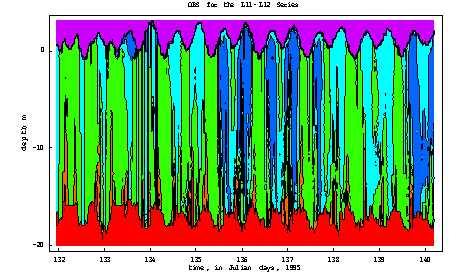![]()
![]()
Tidal Energy and ETM Events
Tidal energy varies over a lunar cycle in the Columbia River estuary. Twice-monthly spring tides result in increased tidal energy, while tidal currents are weaker during the intervening neap tide periods. This cycle is reflected in the intensity of the ETM events that occur several times per day. By comparing the observed and low-passed (filtered to remove the high frequency fluctuations caused by tidal factors) profiles of salinity (a proxy for tidal energy) and optical backscatter [OBS: an estimate of turbidity and surrogate for suspended particulate matter (SPM)], we can determine how tidal energy affects the ETM cycle. This process is explained in the figure legends below. For more detailed information on the physics of the system and the contributions of different tidal components to salinity and OBS profiles, please consult David Jay's home page.

Figure courtesy of David Jay
Physical forcing in an estuarine turbidity maximum (ETM) -- observed salinity (top) and low-passed, subtidal (bottom) during the May 1995 spring freshet. Mean stratification is strong because of the high river discharge, and a reduction in stratification, seen in the lower figure as fewer and broader isohaline zones, just after the spring tide on day 134-135 is evident. Stratification and near bed salinity increase rapidly as the neap tide approaches after day 137. This is represented by a stronger salinity gradient on this date. Stratification due to lower tidal energy is associated with reduced intensity of turbidity maxima events (note the reduced observed and low-passed OBS values in the below figure for days 136-138).


Figure courtesy of David Jay
Response of near-bed processes to tidal and fluvial forcing -- Top: observed OBS shows several sharp turbidity maximum events occur each day. Bottom: low-pass filtered (see explanation above) estimate of OBS. Note that the mean OBS peaks before the spring tide and is actually lowest just after the spring. Apparently, all available organics and fine-grained materials were eroded from the sand bed when or just before the strongest tides occurred. Subsequent strong tidal currents could not erode more material but did export SPM from the system.
![]()